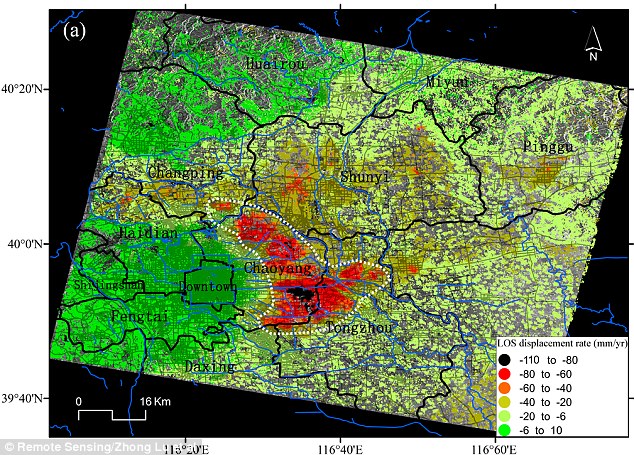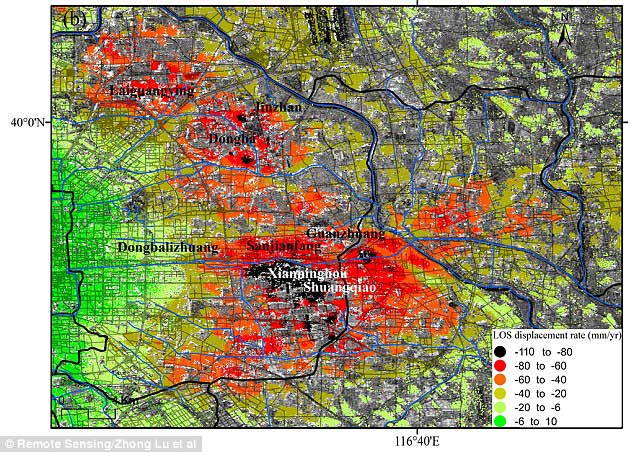

China's capital city, Beijing, has been sinking since 1935. And according to a new study, parts of the country are subsiding as rapidly as four inches (100mm) every year. The authors say the sinking is a sever hazard for the population and the safety of the urban infrastructure.

Researchers said the Chaoyang district, which includes many hotels and office buildings from Beijing’s Central Business District, is the most afflicted area. Different parts of the city and how rapidly they are sinking is shown in the map, with Chaoyang mostly in red
In the paper, published in the journal Remote Sensing, the authors monitored how pumping ground water is causing some parts of China's capital to sink, finding some parts are falling by up to four inches (100mm) a year.
Researchers said the Chaoyang district, which includes many hotels and office buildings from Beijing’s Central Business District, is the most afflicted area.
'The maximum subsidence is seen in the eastern part of Beijing with a rate greater than 100 mm/year,' the authors wrote.
Experts call this drop in evaluation 'subsidence', as it is when the Earth sinks as a response to geological or man-induced causes.

China's capital city, Beijing, has been sinking since 1935. And according to a new study, parts of the country are subsiding as rapidly as four inches (100mm) every year. The authors say the sinking is a sever hazard for the population and the safety of the urban infrastructure

The rapid construction of massive buildings, roads and other infrastructure projects means a lot of extra weight has been put on the ground. Excessive pumping of groundwater is also a major problem that plagues urban areas as they struggle to keep up with rising populations and water demand
The rapid construction of massive buildings, roads and other infrastructure projects means a lot of extra weight has been put on the ground.
Excessive pumping of groundwater is also a major problem that plagues urban areas as they struggle to keep up with rising populations and water demand.
'Located at the northern end of the North China Plain, Beijing is ranked as the 5th most water-stressed city in the world, and groundwater is the main water source for industrial, agricultural and household activities,' the study says.
'With its rapid urban growth, there has been increasing water demand in Beijing.'
The study used satellite images and GPS collected between 2003 and 2010.
The international team of seven scientists and engineers used InSAR radar technology, which monitors land elevation changes.
Earlier this year, using Nasa airborne radar, scientists generated maps that revealed New Orleans and its surrounding areas are sinking at 'highly variable rates'.
The highest rates were found upriver along the Mississippi near industrial areas and in Michoud - both experienced annual drops of up to two inches (50mm).
But some parts of Beijing are sinking twice as fast as New Orleans, according to the new study.
'Land subsidence is a severe geohazard threating the safety of the public and urban infrastructure,' the study says.
'Hence, continuous monitoring of land subsidence is critical for detecting potential hazards and designing compensation strategies.'
Day|Week

 China's first intelligent security robot debuts in Chongqing
China's first intelligent security robot debuts in Chongqing A Total of 3,552 Subscribers Vanish In Two Days; YouTube Closes All Doors to Users’ Inquiries
A Total of 3,552 Subscribers Vanish In Two Days; YouTube Closes All Doors to Users’ Inquiries Out of this world! Futuristic UFO-shaped yacht has its own garden and a stunning underwater viewing deck
Out of this world! Futuristic UFO-shaped yacht has its own garden and a stunning underwater viewing deck An old tea house in Chengdu
An old tea house in Chengdu Furious Customer Crushes All the Buns from Vendor Just Because He Was Given the Wrong Flavor
Furious Customer Crushes All the Buns from Vendor Just Because He Was Given the Wrong Flavor 20 post-90s couples hold ’naked marriage‘ in E. China
20 post-90s couples hold ’naked marriage‘ in E. China Female official wearing traditional Han costume to promote local tourism
Female official wearing traditional Han costume to promote local tourism Over 12,000 Runners Seek Medical Care in S China’s Marathon
Over 12,000 Runners Seek Medical Care in S China’s Marathon Six Luxury Sports Cars Totaled after Fail Attempts to Cross China’s Most Perilous Highway Linking SW China’s Sichuan and Tibet
Six Luxury Sports Cars Totaled after Fail Attempts to Cross China’s Most Perilous Highway Linking SW China’s Sichuan and Tibet Incredible Transformation: “Witch Child”Whose Parents Left Him for Dead in Nigerian Makes Speedy Recovery
Incredible Transformation: “Witch Child”Whose Parents Left Him for Dead in Nigerian Makes Speedy Recovery